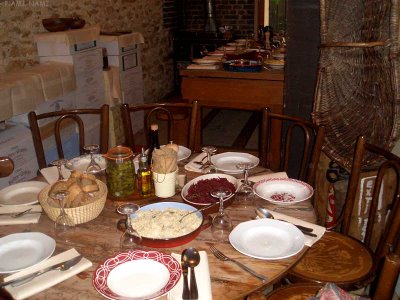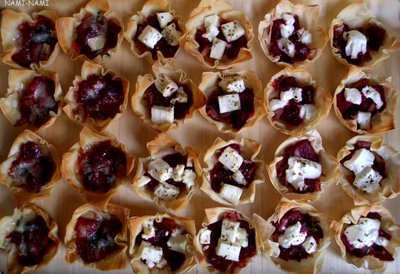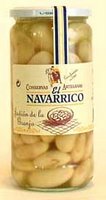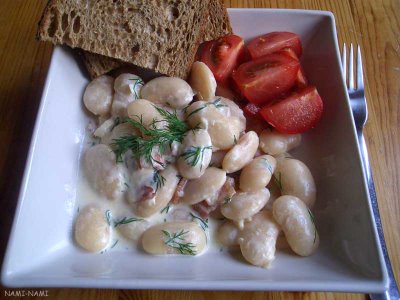This post is way overdue - I went to
Paris three months ago! However, better late than never, and as I've been praising this restaurant to many of my friends, I thought I should also post the write-up and a picture or two.
I've already told that I had wonderful time in Paris, and I was lucky enough to visit the town with someone who knew the city, spoke French and shared my interest in everything food-related. I, on the other hand, knew lots of insider tips as to what's the best place to enjoy
a cup of tea, where to look for the
best macarons, the
foodie heaven for browsing the shelves, the
treasure cellar of various kitchen equipment etc. And all this thanks to being part of this wonderful world of foodblogging, as without you, I would have probably only frequented the most touristy and least exciting eating establishments.
On our third night in Paris, K. and I decided to check out
La Cave de l'Os à Moëlle - the place that had received praises from
Clotilde,
John Whiting, and
Pim. It couldn't have been bad, could it? And it wasn't. We had an exceptional meal there, enjoying the rustic French fare. There is no menu as such - you just eat whatever is served, and the eating is communal. Some of the food is on your table, some food you have to get from the neighbouring tables, resulting in lots of friendly chit-chat and banter and passing of serving plates.
The meal costs 20 Euros per person, and you can eat as much as you want. This being a wine cellar/bar, there is obviously lots to choose from in that department. You pick your own wine from the shelves, prices range from under 10 Euros per bottle to, well, much higher. We opted for a
2001 Domaine Pavelot Pernand-Vergelesses 1er Cru Les Vergelesses, which turned out to be a very fine
grand vin de Bourgogne indeed.
Below is a picture taken just before our meal began. There are two sittings each night, starting at 7.30 pm and 9.30 pm, respectively. We were there for the first sitting on a Saturday night, having not been able to secure a reservation for the night before (hence, booking is essential).
There were three large tables in the main dining area on the back, plus a smaller table in the front. K. and I sat in the round table in the middle, sharing it with a London-based Kiwi girl, who had come to Paris for the weekend together with her parents who were visiting from New Zealand. And then there were three Parisian guys, who eat out together on a weekly basis and had nothing but good things to say about the place, praising both the food and the exceptional value for money. The other two tables were full of joyous French diners.
 Click on the photo to enlarge. Note the stove on the far back. The puddings/desserts were placed on top of the wine boxes on the left
Click on the photo to enlarge. Note the stove on the far back. The puddings/desserts were placed on top of the wine boxes on the left.
On the night we were there, we started with two different types of pate, one of which was
pâté de canard; there was some gutsy celeriac salad, most probably seasoned with chopped lovage (at least that's the joint conclusion I reached with the woman from NZ), which was very tasty (above); beetroot salad (above); stewed leeks; marinated red & green bell peppers; red cabbage; marinated sardines; various crudités (cauliflower, radishes, carrots, courgettes); cornichons; bread.
Then a big pot of tomato-based fish soup was brought out, and everybody helped themselves (the pot was on top of the oven in the far back of the room).
The main course consisted of a very tender and simple boiled beef, served with hot red cabbage & haricots verts, and accompanied with boiled eggs in oil marinade with bay leaves and allspice. All very tasty - the big chunks of beef were especially tender and flavoursome.
The dessert table was also generous. You could choose between pots of crème caramel with lime; madeira cake with a hint of lemon; rice pudding; a simple flan;
îles flottantes/floating islands; pots of chocolate. I was already extremely full, so I opted for the light rice pudding, whereas the men in the table tried several of the available puddings and approved all of them..
And if anyone had room for cheese, then there was a cheese cupboard on the wall containing several choices. I didn't, so cannot really comment on the cheese.
Overall, this was a most interesting - and delicious - dining experience. One that we definitely recommend to our friends and will repeat on our next visit to Paris.
La Cave de l'Os à Moëlle
181, Rue de Lourmel
75015 Paris
(15ème arrondissement)
Métro: Lourmel
Tel : 0826100601
 My recent post about picking cloudberries in Estonia was quite popular, giving me a cheeky idea for this SHF edition. I am aware that sadly these exquisite berries (click on the photo on the right to see them in their full glory) are rather difficult to get hold of in most countries in their fresh form, though IKEA helps to satisfy cloudberry cravings with their cloudberry jam (hjortronsylt) and Lapponia produces a beautiful cloudberry liqueur that really tastes and smells of the real thing. But if none of these are available, then try this jam.
My recent post about picking cloudberries in Estonia was quite popular, giving me a cheeky idea for this SHF edition. I am aware that sadly these exquisite berries (click on the photo on the right to see them in their full glory) are rather difficult to get hold of in most countries in their fresh form, though IKEA helps to satisfy cloudberry cravings with their cloudberry jam (hjortronsylt) and Lapponia produces a beautiful cloudberry liqueur that really tastes and smells of the real thing. But if none of these are available, then try this jam.
















